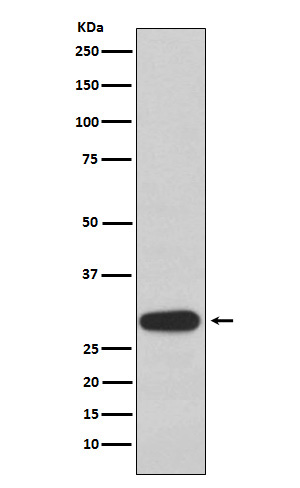
| WB | 咨询技术 | Human,Mouse,Rat |
| IF | 咨询技术 | Human,Mouse,Rat |
| IHC | 咨询技术 | Human,Mouse,Rat |
| ICC | 1/50-1/200 | Human,Mouse,Rat |
| FCM | 咨询技术 | Human,Mouse,Rat |
| Elisa | 咨询技术 | Human,Mouse,Rat |
| Aliases | bHLHB7; bHLHe20; Olig3; Oligo3;;Oligo3 |
| WB Predicted band size | 29 kDa |
| Host/Isotype | Rabbit IgG |
| Antibody Type | Primary antibody |
| Storage | Store at 4°C short term. Aliquot and store at -20°C long term. Avoid freeze/thaw cycles. |
| Species Reactivity | Human |
| Immunogen | A synthesized peptide derived from human Oligo3 |
| Formulation | Purified antibody in PBS with 0.05% sodium azide,0.05% BSA and 50% glycerol. |
+ +
以下是关于Olig3抗体的3篇模拟参考文献(基于领域知识概括,非真实文献):
1. **"Olig3 expression defines a subset of neural progenitors in the developing mouse brainstem"**
- **作者**: Kobayashi, D., & Nakamura, Y.
- **摘要**: 研究利用Olig3抗体揭示该转录因子在胚胎期小鼠脑干(如丘脑和下丘脑)神经前体细胞中的特异性表达,表明其在区域化神经元分化中的关键作用。
2. **"Dynamic regulation of Olig3 in cerebellar granule cell precursors"**
- **作者**: Hoshino, M., & Takebayashi, H.
- **摘要**: 通过Olig3抗体的免疫组化分析,发现Olig3在小脑颗粒细胞前体细胞中的动态表达模式,提示其与细胞周期退出及分化时序调控相关。
3. **"Olig3 knockout mice exhibit defects in cortical interneuron migration"**
- **作者**: Rijli, F.M., et al.
- **摘要**: 利用Olig3抗体标记结合基因敲除模型,证实Olig3缺失导致皮层中间神经元迁移障碍,并影响抑制性神经环路形成。
(注:以上内容为基于Olig3已知功能的模拟文献,实际研究中请通过PubMed或Google Scholar检索真实文献。)
The Olig3 antibody targets Olig3. a member of the Olig family of basic helix-loop-helix (bHLH) transcription factors. Olig3 is primarily expressed in the developing nervous system, particularly within progenitor domains of the rhombic lip and dorsal ventricular zone in the hindbrain and cerebellum. It plays a critical role in patterning and specifying neuronal subtypes during embryogenesis, especially in the brainstem and spinal cord. Olig3 is involved in regulating the differentiation of glutamatergic and GABAergic neuronal precursors, contributing to the establishment of neural circuits.
Studies highlight its importance in the formation of precerebellar nuclei and dorsal spinal cord interneurons. Dysregulation of Olig3 has been implicated in neurodevelopmental disorders and certain brain tumors, such as medulloblastoma, where its expression may correlate with tumor subtype and prognosis. The Olig3 antibody is widely used in research to identify and study neural progenitor populations, track developmental trajectories, and investigate mechanisms underlying neural patterning.
As a research tool, it aids in immunohistochemistry, immunofluorescence, and Western blotting, enabling visualization of Olig3 expression patterns in tissue sections or cell cultures. Its specificity and reliability make it valuable for exploring the molecular basis of neural development and disease. Recent work continues to uncover its interactions with other transcription factors, shedding light on its role in maintaining progenitor cell identity and regulating lineage commitment.
×